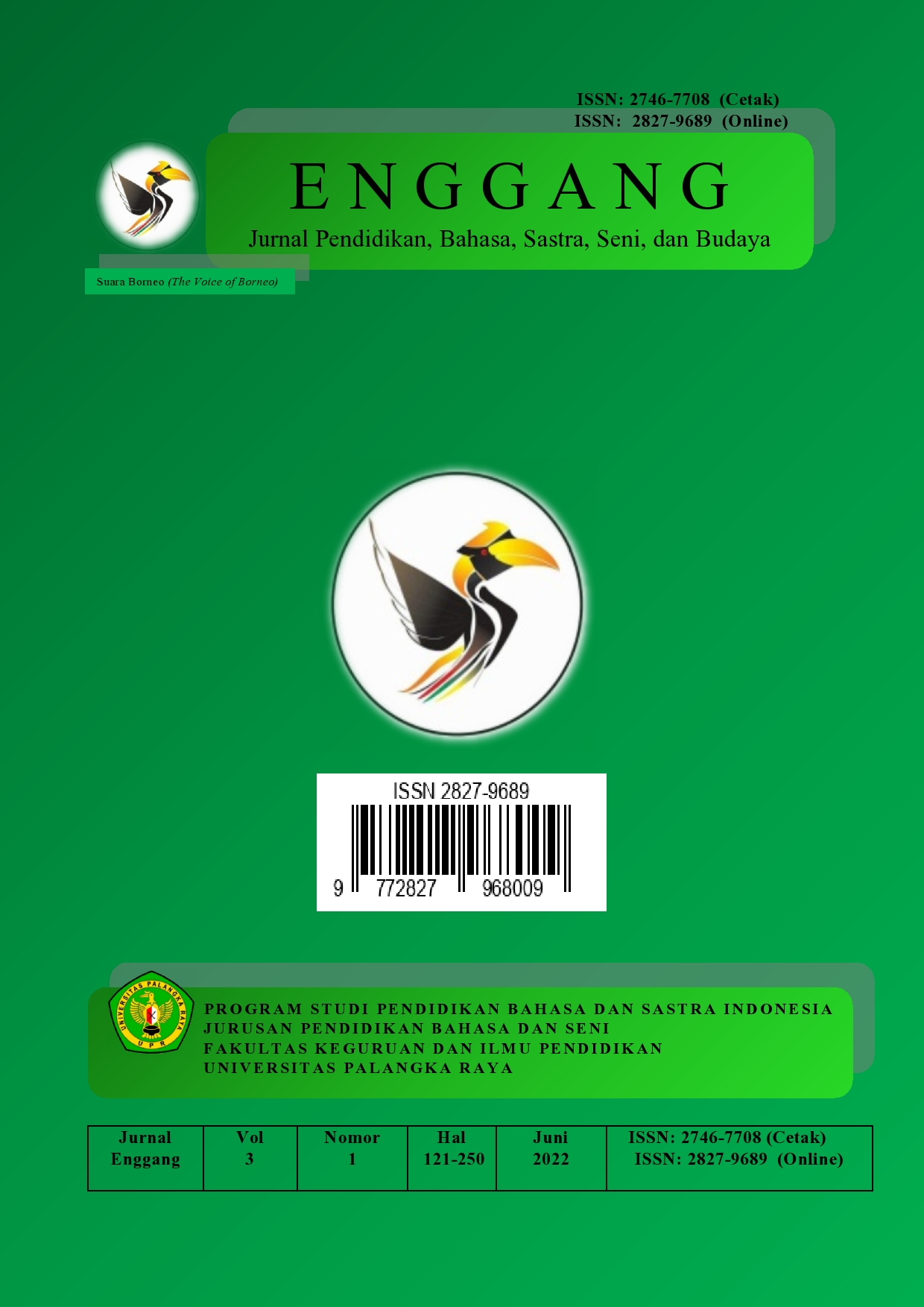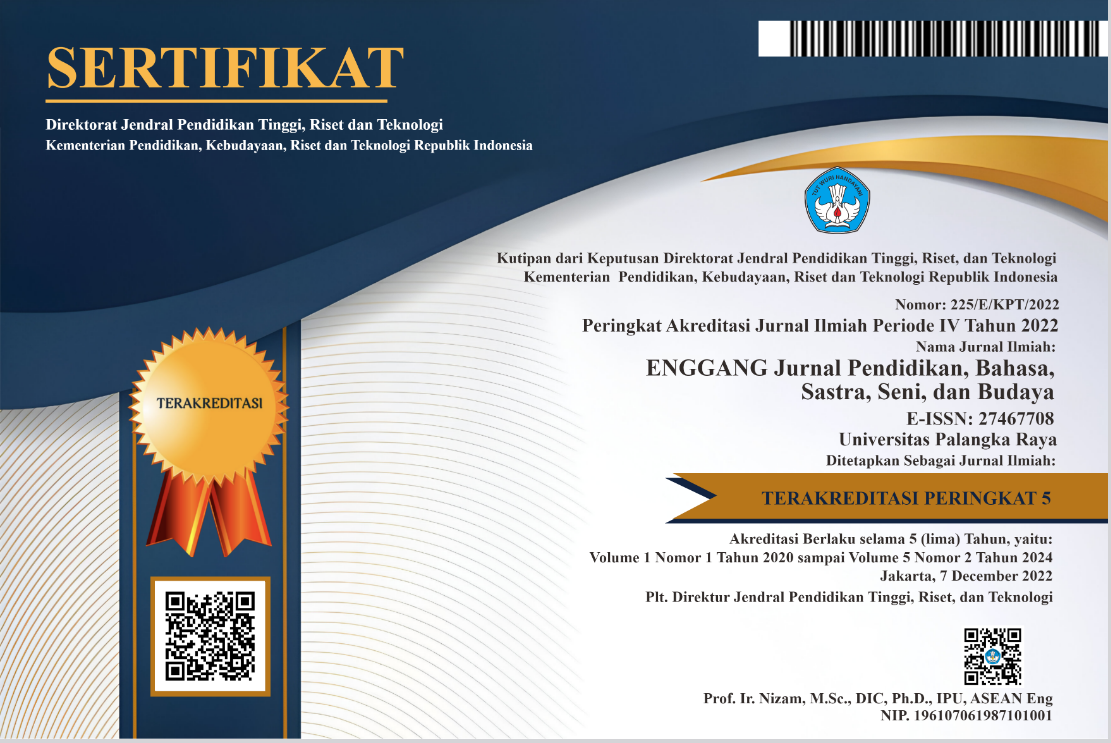Pemertahanan Nilai Budaya Suku Dayak Maanyan Melalui Narasi Fabel di Daerah Aliran Sungai Barito
DOI:
https://doi.org/10.37304/enggang.v5i1.19033Keywords:
Fable, Dayak Maanyan, Community ValuesAbstract
The Dayak Maanyan culture has traditional values that can be seen in the Popular Fables of the Dayak Maanyan Tribe. These values are introduced from generation to generation, so that the values in the Dayak Maanyan tribe are not destroyed. The childhood of the Dayak Maanyan tribe is built through the storytelling of the Popular Fables of the Dayak Maanyan Tribe. Parents in the Dayak Maanyan tribe are important agents in educating their children regarding the values of the Dayak Maanyan tribe that can be conveyed through the Popular Fables of the Dayak Maanyan Tribe. This study will examine the intrinsic and extrinsic elements contained in the Popular Fables of the Dayak Maanyan Tribe. The intrinsic values that will be studied are the cultural values and cultural identity of the Dayak Maanyan tribe in the Popular Fables of the Dayak Maanyan Tribe. While the extrinsic values that will be studied are efforts to maintain cultural values and increase understanding and appreciation of the culture of the Dayak Maanyan tribe in the popular fable book of the Dayak Maanyan Tribe. The method used is qualitative descriptive, where all data is qualitative data that is studied and analyzed in the form of descriptions. The expected results are to provide understanding, show roles, identify strategies and preservation efforts, and provide recommendations related to the popular Dayak Maanyan fable book.Downloads
References
Affandi, M. (2019). Pemberdayaan Masyarakat Adat Suku Dayak Maanyan Desa Tuyau Melalui Program Pendidikan Keaksaraan Usaha Mandiri. Jurnal Ilmu Sosial.
Danandjaja, J. (2007). Folklor Indonesia: Ilmu Gosip, Dongeng, dan Lain-lain. Jakarta : Pustaka Utama Grafiti.
Gadamer, H.-G. (2004). Kebenaran dan Metode: Pengantar Filsafat Hermeneutika. Yogyakarta: Pustaka Pelajar.
Helmon, S., & Rahadi, R.K. (2020). Local Values Preservation of Torok Oral Tradition Through Education Domain: Metaphorical Ecolinguistics Perspective. Jurnal Gramatika.
Jabar, N. A., Sukri, S., Jamal, D. D., Kiffli, S., & Suliman, M. S. (2024). Literature and Cultural Ecology: The Relationship Between Folklore and Enviromental Sustainibility. BIO Web of Conferences (pp. 1-8). Malaysia: EDP Sciencess.
Jakarias, & Dedi, A. (2025). Folklor dalam Upacara Baremah Tau't Binua Dait: Antara Tradisi dan Kepercayaan Mistis Masyarakat Dayak. Rhizome: Jurnal Kajian Ilmu Humaniora, 26-38.
Kau, S. A. (2019). Hermeneutika Gadamer dan Relevansinya dengan Tafsir. Journal IAIN Gorontalo, 109-123
Kaminski, Mary. "The Fable as a Teaching Tool". Educational Perspectives, Vol. 52, No. 1, 2019.
Kim, Y., Chang, Y., Karpinska, M., Garimella, A., Manjunatha, V., Lo, K., . . . Iyyer, M. (2024). Fables: Evaluating Faithfulness and Content Selection in Book-Length Summarization. 1st Conference on Language Modeling (pp. 1-41). New York: Cornell University.
Krippendorff, K. (2018). Content Analysis: An Introduction to Its Methodology. Sage Publications.
Lesnik-Oberstein, K. (2004). Introduction. Children's Literature: New Approaches. In K. Lesnik-Oberstein, Children's Literature: New Approaches. London: Routledge.
Malawat, I. (2022). Nilai Pendidikan Karakter dalam Dongeng Burung Kasuari dan Cenderawasih. BISAI: Jurnal Bahasa, Sastra, dan Pengajaran, 18-27.
Nasution, H. (2021). Interpretasi Karakter Hewan dalam Fabel: Kajian Hermeneutika. Loa : Jurnal Ketatabahasaan dan Kesusastraan, 110-118.
NN. (2022, Juni 13). BURUNG SARIAK/SAKUTE. Retrieved Mei 14, 2023, from Visit Bartim: https://visitbartim.com/read/256/burung-sariaksakute.html
Nurgiantoro, B. (2010). Teori Pengkajian Fiksi. Yogyakarta: Gajah Mada University Press.
Nurgiyantoro, B. (2013). Sastra Anak; Pengantar Pemahaman Dunia Anak. Yogyakarta: Gadjah Mada University Press.
Pradopo, R. (2000). Pengkajian Puisi. Yogyakarta: Universitas Gajah Mada Press.
Poerwadi, Petrus., Perdana , Indra., Linarto, Lazarus., Christy, Nirena Ade. (2023). Fabel Populer Dayak Maanyan. Yogyakarta: Jejak Pustaka.
Saputra, I. T., & Wicaksono, I. (2024). Efektivitas Program Sekolah Adat Kampung Batara (Baca Taman Rimba) di Lingkungan Papring Kabupaten Banyuwangi. E-Journal Warunayama.
Saefuddin. (2021). Pendidikan Karakter dalam Cerita Fabel Banjar. Tuah Talino: Jurnal Ilmiah Bahasa dan Sastra, 282-298.
Setyorini, R., Suwandi, S., & Andayani. (2023). Use of Folk Stories in Indonesian Language Textbooks as Strengthening Character and Culture of Junior High School Students. Proceedings of the 3rd International Conference of Humanities and Social Science (pp. 1-11). Surakarta: EAI.
Sugiyono. (2017). Metode Penelitian Kuantitatif, Kualitatif, dan R&D. Jakarta: Alfabeta.
Sugiyono (2023). Metode Penelitian Kuantitatif. Bandung: Alfabeta.
Sulistyorini. (2014). Analisis Teks Fabel dalam Pembelajaran Bahasa Indonesia di Sekolah Dasar. Jurnal Pendidikan Dasar, 626-635.
Sumaryono, E. (1993). Hermeneutika Sebuah Metode Filsafat. Yogyakarta: Kanisius.
Umam. (2021). Pengertian Struktur Fabel: Ciri-Ciri, Jenis, Unsur Intrinsik, dan Contohnya. Retrieved Mei 15, 2023, from Gramedia Blog: https://www.gramedia.com/literasi/struktur-fabel/













